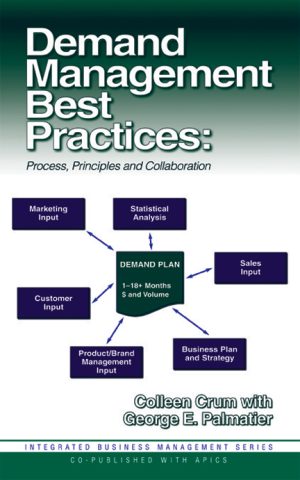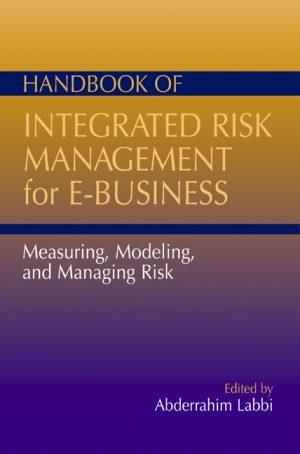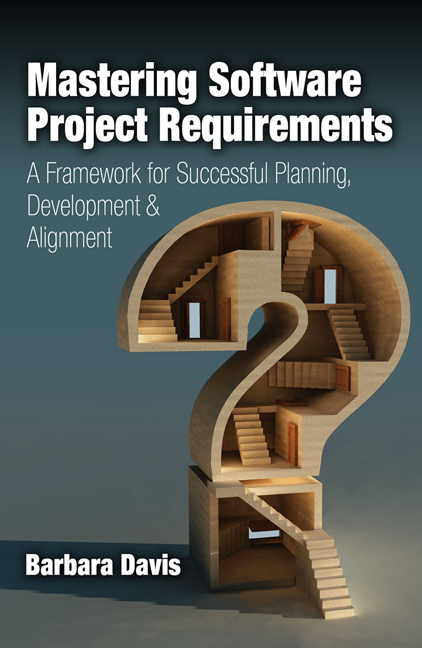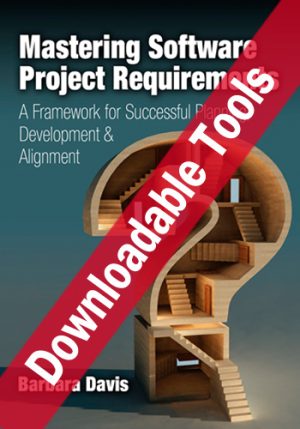Mastering Software Project Requirements
$54.95
A Framework for Successful Planning, Development & Alignment
By Barbara Davis
Hardcover, 6×9, 296 pages
ISBN: 978-1-60427-091-4
September 2013
LEARN & EARN: Get 6.4 PDUs in the PMI skill areas of Technical or Strategic and Business Management Skills
Description
This book is a concise step-by-step guide to building and establishing the frameworks and models for the effective management and development of software requirements. It describes what great requirements must look like and who the real audience is for documentation. It then explains how to generate consistent, complete, and accurate requirements in exacting detail following a simple formula across the full life cycle from vague concept to detailed design-ready specifications.
Mastering Software Project Requirements will enable business analysts and project managers to decompose high-level solutions into granular requirements and to elevate their performance through due diligence and the use of better techniques to meet the particular needs of a given project without sacrificing quality, scope, or project schedules.
Key Features
- Identifies the attributes of good requirements and illustrates the life cycle from elicitation to analysis, specification to validation, explaining how to estimate, measure, benchmark, plan, manage, and deliver great software project requirements
- Presents a solid and reproducible framework for generating great requirements within the parameters of a specific project or enterprise architecture methodology and in projects that are agnostic of methodology
- Explains how various methodologies impact the results of requirements activities and provides strategies for adapting and aligning requirements activities to project frameworks and corresponding methodologies (Agile, Waterfall, WAgile, TOGAF and DO-178) to ensure the integrity of the requirements is maintained across multiple project frameworks
- Covers every shred of requirements documentation that a business analyst or project manager will consume and produce, as well as the context and audience of each artifact and deliverable created
- Re-defines the requirements process in pragmatic detail, and enables technology and business organizations to: reduce operating costs, increase alignment between technology products and business needs, and maximize return on investment of every implemented business solution by providing detailed task descriptions, key performance indicators, and benefits realization planning
- WAV offers downloadable templates for every aspect of requirements including estimation, and provides materials for academic instruction — available from the Web Added Value™ Download Resource Center
About the author(s)
Barbara Davis is President of RQX Global Training & Consulting, LLC, an organization that provides technology management and profit management solutions for projects, resources, portfolios, and IT services. Mrs. Davis is a proven thought leader and expert in business analysis, project management, and various aspects of IT management and business. She has been a champion of business analysis and technology standards and infrastructure for the past 13 years, during which time she developed the world’s first university accredited business analysis diploma program, proprietary resource maturity and requirements methodologies, and a global online business analysis training program.
Prior to entering the technology field, Barbara gained more than 15 years of functional business experience in operational management, project management, change management, and training. She currently works with Fortune 500 companies to align business analysis services, critical projects, and operational infrastructure to ensure successful outcomes in the face of conflict and very challenging circumstances. Davis is also an international speaker and author of Managing Business Analysis Services: A Framework for Sustainable Projects and Corporate Success (2012).
Table of Contents
PREFACE
SECTION I: IDENTIFYING & UNDERSTANDING THE BUSINESS SOLUTION
CHAPTER 1: IDENTIFYING THE SOLUTION
Defined Verses Undefined Solution Starting Points
Defining the Business Need, Vision & Mission
Managing to the Exception
Understanding Business Architecture
Benefits Realization Planning
CHAPTER 2: STAKEHOLDER INVOLVEMENT & MANAGEMENT
The Seinfeld Approach to Requirements
Setting & Managing Expectations
Beyond RACI: Getting Sponsors, Business Owners and User Groups Involved
RACI Matrix
Why Some People Contribute and Others Don’t
Why Opportunity Alone Does Not Equal Contribution and Increase Participation
Types of Participation
Creating the Right Conditions and Environment Increases Participation
Informational Activities
Input Funnels
SECTION II: REQUIREMENTS PLANNING & MANAGEMENT
CHAPTER 3: THE EVOLUTION OF REQUIREMENTS ON A PROJECT
Inherent Project Risks to Requirements
Risks from Project Inception
Risks from Project Resources
5 Critical Requirements Steps That Get Missed: What Business Analysts Are Not Doing (Consistently)
Research
Gap Assessment (vs. Gap Analysis)
Ambiguity Management
Requirements Validation
Facilitated Sign-Off
Quantifying Effectiveness of Requirements Activities
The Golden Rules of Requirements
Attributes of Great Requirements
CHAPTER 4: REQUIREMENTS MANAGEMENT & DEVELOPMENT STRATEGY
Developing a Requirements Management Strategy
Planning Requirements Management
Preparing for Requirements Management
Requirements Management Activities
Tools and Techniques for Requirements Management
Traceability
Change Control
Ambiguity Management
Requirements Management Tool
Naming & Numbering Conventions
CHAPTER 5: ESTABLISHING METRICS & BENCHMARKS
Inputs for Metrics and Benchmarking
Outputs as Quantifiable Results
Measuring Requirements Effectiveness
Calculating the Requirements Effectiveness Index
Calculating the Requirements Quality Index
Calculating the Requirements Productivity Index
Business Priority & Criticality
Functional Complexity
Estiminating Requirements Activities
SECTION III: ALL THINGS REQUIREMENTS
CHAPTER 6: ELICITATION
From Business Objective and Problem, to Scope and Requirements
Inputs & Outputs of Elicitation
Knowing Where to Find Sources for Requirements
Why Each Source Is Valuable in Elicitation
Tribal Knowledge
Project Scope
Project Charter
Project Plan
High Level Requirements
Business Architecture Documentation
Enterprise Architecture Documentation
What Information Is Collected During Elicitation?
The Risks of Excluding Business Analysts in Implementing COTS
How Is This Information Used During Elicitation?
What Artifacts and Deliverable Will Be Created In Elicitation?
High- to Mid-Level Requirements Evolution (Refinement)
Tools and Techniques for Defining the Future State
Business Process Modeling
Business Rule Scope and Dependencies
Who Will Use the Artifacts and Deliverables From Elicitation?
How Are the Artifacts and Deliverables from Elicitation Used?
Tasks & Activities of Eliciting Requirements
Joint Application Development (JAD) Sessions
CHAPTER 7: ANALYSIS
Inputs & Outputs for Analysis
How Is This Information Used During Analysis
Business Process Models
Current State Definition
Future State Definition Outline
Business Architecture
Enterprise Architecture
What Artifacts Are Created During Analysis?
Scenario Definition
Gap Analysis
Cause and Effect Tables
Who Will Use the Artifacts & Deliverables?
How Will the Artifacts & Deliverables Be Used?
Gap Analysis
Scenarios
Activity Diagrams
Use Case Definition Outlines
Cause and Effect Tables
Exit Criteria For Analysis
CHAPTER 8: SPECIFICATION
Writing Testable Requirements
Inputs/Outputs of Specification
What Artifacts and Deliverables are Created in Specification?
Requirements Document
Who Signs Off on Low Level Requirements?
Finalized Business Rules
Business Rules Refinement
Use Case Definition/Refinement
Who Will Use the Artifacts and Deliverables from Specification?
How the Artifacts and Deliverables from Specification can be Utilized – Contributed by James Canter
Tasks and Activities of the Specification Stage
Business Rules
Low-Level Requirements Document
Individual Requirement Structure
Updating Use Cases
Future State Definition Refinement
Exit Criteria for Specification
CHAPTER 9: VALIDATION
Inputs & Outputs of Validation
What Artifacts & Deliverables Are Created in Validation?
Who Signs Off on Validation?
Requirement Traceability
Tasks & Activities In Validation
Assessing Business Criticality and Priority
Techniques for Validating Requirements
Cause & Effect (Decision) Tabling
Scenarios
Use Cases
Ambiguity Reviews and Tracking
Tools and Techniques for Ambiguity Reviews
Ambiguity Workshops
Numbering Requirements
Facilitated Sign-Off of Requirements
Exit Criteria for Requirements Validation
SECTION IV: IN CONTEXT OF PROJECT & ARCHITECTURE METHODOLOGIES
CHAPTER 10: IMPLICATIONS OF AGILE ON REQUIREMENTS
Misconceptions About Agile
Impacts of Agile on Requirements
Strengths of Agile
Risks of Agile SDLC
CHAPTER 11: IMPLICATIONS OF WATERFALL ON REQUIREMENTS
Misconceptions About Waterfall
Impacts of Waterfall on Requirements
Using Waterfall to Manage Change
Change Management
Change Control
Strengths of Waterfall
Risks of Waterfall SDLC
CHAPTER 12: IMPLICATIONS OF WAGILE ON REQUIREMENTS
Misconceptions About WAgile
Impacts of WAgile on Requirements
Strengths of WAgile
Risks of WAgile SDLC
CHAPTER 13: IMPLICATIONS OF TOGAF ENTERPRISE ARCHITECTURE ON REQUIREMENTS
Misconceptions About TOGAF
Impacts of TOGAF on Requirements
Strengths of TOGAF EA Methodology
Risks of TOGAF EA Methodology
CHAPTER 14: HOW BUSINESS ANALYSIS CAN LEVERAGE DO-178C AVIATION ENGINEERING SPECIFICATIONS
DO-178 Framework
Software Planning Process
Software Development Process
Software Requirements Process
Software Design Process
Software Coding Process
Integration Process
Traceability
Correctness, Confidence and Control Process
Verification
Configuration Management
Quality Assurance
Transferrable DO-178 Elements (Applicability & Implications To Commercial Software)
Strengths of DO-178
APPENDIX A: WRITING EFFECTIVE EMAILS
APPENDIX B: SAMPLE DOCUMENT TEMPLATES
Ambiguity Log Content Sample
BA Deliverables and Artifacts Index Content Sample
Business Rules Content Sample
Change Control Log Document Content Sample
Current State Document Content Sample
Future State Definition Document Content Sample
GAP Analysis Content Sample
High Level Requirements Document Content Sample
Requirements Document Content Sample
Requirements Risk Assessment Document Content Sample
Reviews
“Mastering Software Project Requirements is an eye-opening look inside the world of requirements analysis that outlines the main reasons software and IT projects fail, and then shows how to succeed. It explains why requirements analysis is much more than just a list of features, and details multiple strategies and tactics to create the right requirements for any project.”
—Vincent Serpico, CEO, Spotlight Software
“Mastering Software Project Requirements is a fabulous book that should appeal to and provide value for novices and experts alike. The breadth of what it covers is pretty remarkable for a book this size. While I found literally every section had something very useful to offer, the chapter on ‘Establishing Metrics and Benchmarks’ is particularly interesting and brimming with potential. This is an area that is so incredibly important (“you can’t control what you can’t measure” – DeMarco), and yet so rarely do you open a book on business analysis or requirements these days and find anything significant on the topic. True to form, the author lays out a pragmatic approach for establishing a requirements measurement framework that any organization could adopt – regardless of their maturity in the area.
After taking you through a journey from ‘Defining the Business Need, Vision, and Mission’ all the way through ‘Elicitation’, ‘Analysis’, ‘Specification’ and ‘Validation’ of the solution requirements, you then find a fantastic section on how all these requirements practices are adjusted/bent/shaped/twisted when applied in contrasting real-world situations. One thing is obvious when reading this book—the author is relating lessons that were learned the hard way, and is doing the reader a favor by passing them on. If you’re a business analyst, new to the role or experienced, do yourself a favor – and read this book.”
—Tony Higgins, VP Product Marketing, Blueprint Software Systems
You may also like…
Related products
-

Demand Management Best Practices
Retail Price: $54.95$49.95 Add to cart -

Achieving Project Management Success Using Virtual Teams
Retail Price: $49.95$39.95 Add to cart -

Aircraft Finance
Retail Price: $99.95$89.95 Add to cart -

Handbook of Integrated Risk Management for E-Business
Retail Price: $89.95$69.95 Add to cart -

Essential Project Investment Governance and Reporting
Retail Price: $59.95$49.95 Add to cart




